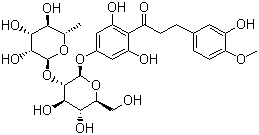Neohesperidin dihydrochalcone
Inquiry
| Post Date: | Feb 16,2025 | ||||||||||||||||||||||||||||
| Expiry Date: | Aug 15,2025 | ||||||||||||||||||||||||||||
| Detailed Description: |
Cas No. :20702-77-6
Product Name:Neohesperidin dihydrochalcone Botanical Name:Citrus aurantium Part Used: Fruit Application: Natural Sweetener Brief Info:1-99% ..................................................................................................................................... Active Ingredient:Neohesperidin dihydrochalcone CAS No.:20702-77-6 M.Formula: C28H36O15 M.Weight:612.58 Structural formula:
..................................................................................................................................... Specification (1)1-99% Neohesperidosyl dihydrochalcone ..................................................................................................................................... Description Neohesperidin dihydrochalcone, sometimes abbreviated to neohesperidin DC or simply NHDC, is an artificial sweetener derived from citrus. NHDC was discovered during the 1960s as part of a United States Department of Agriculture research program to find methods for minimizing the taste of bitter flavorants in citrus juices. Neohesperidin is one such bitter compound. When treated with potassium hydroxide or another strong base, and then catalytically hydrogenated, it becomes NHDC, a compound roughly 15001800 times sweeterthan sugar at threshold concentrations; around 340 times sweeter than sugar weightfor weight. Its potency is naturally affected by such factors as the application in which it is used, and the pH of the product.Like other highly sweet glycosides, such as glycyrrhizin and those found in stevia, NHDC's sweet taste has a slower onset than sugar's and lingers in the mouth for some time. Unlike aspartame, NHDC is stable to elevated temperatures and to acidic or basic conditions, and so can be used in applications that require a long shelf life. NHDC itself can stay foodsafe for up to five years when stored in optimal conditions. The European Union approved NHDC's use as a sweetener in 1994. It has not been approved as a sweetener in the United States. It is sometimes said that NHDC is considered a Generally Recognized as Safe flavour enhancer by the Flavour and Extract Manufacturers' Association, which is a trade group with no legal standing. NHDC has never appeared on the FDA's GRAS listing. It is particularly effective in masking the bitter tastes of other compounds found in citrus, including limonin and naringin. Industrially, it is produced by extracting neohesperidin from the bitter orange, and then hydrogenating this to make NHDC. The product is well known for having a strong synergistic effect when used in conjunction with other artificial sweeteners such as aspartame, saccharin, acesulfame potassium, and cyclamate, as well as sugar alcohols such as xylitol. NHDC usage boosts the effects of these sweeteners at lower concentrations than would otherwise be required; smaller amounts of other sweeteners are needed. This provides a cost benefit. As a flavour enhancer, NHDC is used in a wide range of products and is indicated by the E number E 959. It is noted particularly for enhancing sensory effects (known in the industry as 'mouth feel'). An example of this is 'creaminess' in dairy foods such as yogurt and ice cream, but is also widely favoured for use in otherwise naturally bitter products. Pharmaceutical companies are fond of the product as a means of reducing the bitterness of pharmacological drugs in tablet form, and it has been used for livestock feed as a means of reducing feeding time. Other products NHDC can be found in may include a wide variety of alcoholic beverages (and nonalcoholic), savoury foods, toothpaste, mouthwash and condiments such as ketchup and mayonnaise. NHDC in pure form is found as a white substance not unlike powdered sugar. In food it is used as a flavour enhancer in concentrations of around 45 parts per million (ppm) and as an artificial sweetener at around 15-20 ppm. Research has shown that at strengths of around and above 20 ppm, NHDC can produce side effects such as nausea and migraine. This is not widely documented, however is unquestionably known within the food science communities that have worked with the product, and many recommend wearing a surgical mask when handling pure NHDC. ..................................................................................................................................... Certificate of Analysis
|
| CAS Registry Number: | 20702-77-6 |
| Synonyms: | ;neohesperidin dihydrochalcone from*citrus fruit;Neosperidin dihydrochalcone;3,5-dihydroxy-4-[3-(3-hydroxy-4-methoxyphenyl)propanoyl]phenyl 2-O-(6-deoxy-alpha-L-mannopyranosyl)-beta-D-glucopyranoside; |
| Molecular Formula: | C28H36O15 |
| Molecular Weight: | 612.5764 |
| Molecular Structure: | 
|
| Company: | Hunan Huacheng Biotech,Inc. [ China ] |
| Contact: | Mr Huang |
| Tel: | 086-0731-82298388 |
| Fax: | 086-0731-88988118 |
| Email: | sales@huachengbio.com |
-
Disclaimer statement:The information and data included above have been realized by the enterprises and compiled by the staff, and are subject to change without notice to you. The Chemnet makes no warranties or representations whatsoever regarding the facticity, accuracy and validity of such information and data. In order to ensure your interest, we suggest you chose the products posted by our gold suppliers or VIP members.

-
- Bilberry Extract
- Luo Han Guo Extract
- European bilberry extract
- Cranberry extract
- Cordyceps Extract
- Chinese bilberry extract
- Blueberry extract
- Shikonin
- Rutin
- Quercetin
- Products--plant monomer
- Naringin
- L-Theanine
- Hesperidin
- Ferulic Acid
- Emodin
- EGCG
- Curcumin
- Andrographolide
- 5-HTP
- Reishi Mushroom Extract
- Trans-Resveratrol
- Tongkat Ali
- Irvingia Gabonensis Seed E...
- Huperzine A


